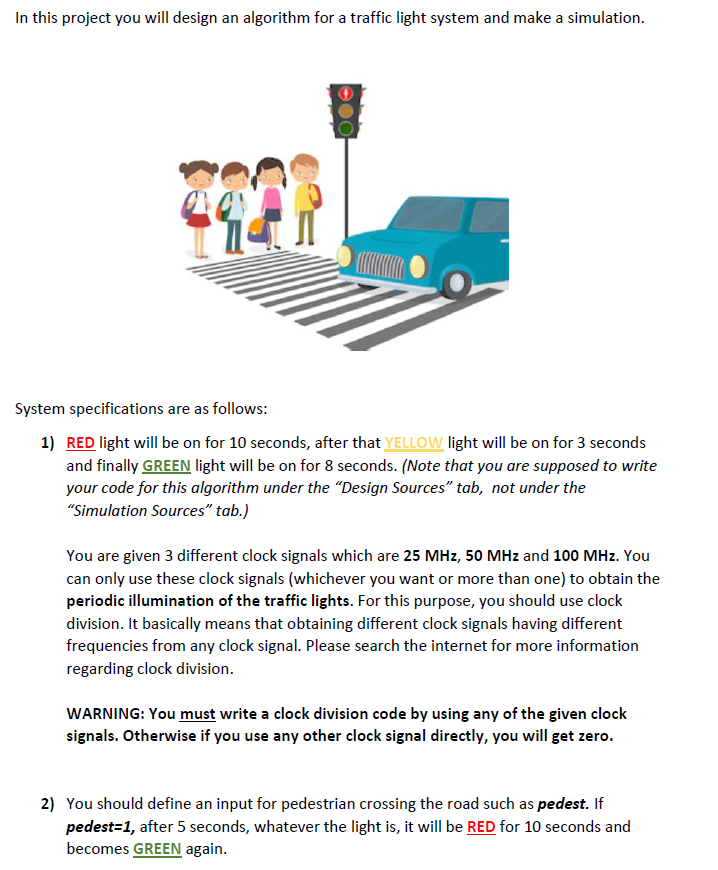Answered step by step
Verified Expert Solution
Question
1 Approved Answer
in verilog In this project you will design an algorithm for a traffic light system and make a simulation. System specifications are as follows: 1)


in verilog
In this project you will design an algorithm for a traffic light system and make a simulation. System specifications are as follows: 1) RED light will be on for 10 seconds, after that YELLOW light will be on for 3 seconds and finally GREEN light will be on for 8 seconds. (Note that you are supposed to write your code for this algorithm under the Design Sources tab, not under the Simulation Sources" tab.) You are given 3 different clock signals which are 25 MHz, 50 MHz and 100 MHz. You can only use these clock signals (whichever you want or more than one) to obtain the periodic illumination of the traffic lights. For this purpose, you should use clock division. It basically means that obtaining different clock signals having different frequencies from any clock signal. Please search the internet for more information regarding clock division. WARNING: You must write a clock division code by using any of the given clock signals. Otherwise if you use any other clock signal directly, you will get zero. 2) You should define an input for pedestrian crossing the road such as pedest. If pedest=1, after 5 seconds, whatever the light is, it will be RED for 10 seconds and becomes GREEN again. 3) Write a simulation source code and show clearly inputs and outputs for different cases. Please give logical names for inputs and outputs such as RED, GREEN etc. instead of a, b, c etc. BONUS: If you can improve your code according to the following intersection point you will get extra credit. Traffic lights should work in harmony so that the traffic is not disrupted. As you can see in the figure, when car 1 and 2 are passing, car 3 and 4 stop and vice versa. Duration of the lights is up to you. You should consider pedestrians crossing the road in this case either. TRAFFIC LIGHT 1 1 TRAFFIC LIGHT 4 TRAFFIC LIGHT 3 3 TRAFFIC LIGHT 2 4 so 2 In this project you will design an algorithm for a traffic light system and make a simulation. System specifications are as follows: 1) RED light will be on for 10 seconds, after that YELLOW light will be on for 3 seconds and finally GREEN light will be on for 8 seconds. (Note that you are supposed to write your code for this algorithm under the Design Sources tab, not under the Simulation Sources" tab.) You are given 3 different clock signals which are 25 MHz, 50 MHz and 100 MHz. You can only use these clock signals (whichever you want or more than one) to obtain the periodic illumination of the traffic lights. For this purpose, you should use clock division. It basically means that obtaining different clock signals having different frequencies from any clock signal. Please search the internet for more information regarding clock division. WARNING: You must write a clock division code by using any of the given clock signals. Otherwise if you use any other clock signal directly, you will get zero. 2) You should define an input for pedestrian crossing the road such as pedest. If pedest=1, after 5 seconds, whatever the light is, it will be RED for 10 seconds and becomes GREEN again. 3) Write a simulation source code and show clearly inputs and outputs for different cases. Please give logical names for inputs and outputs such as RED, GREEN etc. instead of a, b, c etc. BONUS: If you can improve your code according to the following intersection point you will get extra credit. Traffic lights should work in harmony so that the traffic is not disrupted. As you can see in the figure, when car 1 and 2 are passing, car 3 and 4 stop and vice versa. Duration of the lights is up to you. You should consider pedestrians crossing the road in this case either. TRAFFIC LIGHT 1 1 TRAFFIC LIGHT 4 TRAFFIC LIGHT 3 3 TRAFFIC LIGHT 2 4 so 2Step by Step Solution
There are 3 Steps involved in it
Step: 1

Get Instant Access to Expert-Tailored Solutions
See step-by-step solutions with expert insights and AI powered tools for academic success
Step: 2

Step: 3

Ace Your Homework with AI
Get the answers you need in no time with our AI-driven, step-by-step assistance
Get Started


